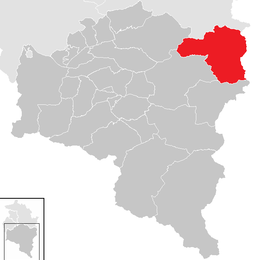
Vorarlberg is the westernmost state of Austria. It has the second-smallest geographical area after Vienna and, although it also has the second-smallest population, it is the state with the second-highest population density. Two thirds of the country are situated above 1,000m. It borders three countries: Germany, Switzerland, and Liechtenstein. The only Austrian state that shares a border with Vorarlberg is Tyrol, to the east.

Bludenz is a town in the westernmost Austrian state of Vorarlberg with around 15.000 inhabitants. It is the administrative seat of the Bludenz District, which encompasses about half of Vorarlberg's territory.

Montafon is a 39 km long valley in the westernmost Austrian federal state of Vorarlberg.

Sankt Anton am Arlberg, commonly referred to as St Anton, is a village and ski resort in the Austrian state of Tyrol. It lies in the Tyrolean Alps, with aerial tramways and chairlifts up to 2,811 m (9,222 ft), yielding a vertical drop of 1,507 m (4,944 ft). It is also a popular summer resort among trekkers and mountaineers.

The Arlberg is a massif between Vorarlberg and Tyrol in Austria. The highest peak is the Valluga at 2,811 metres (9,222 ft). Ski resorts at the Arlberg include Lech, Zürs, Stuben, St. Christoph, St. Anton, Oberlech, Stubenbach, Zug, and Warth.

Zürs is one of the most renowned winter sports resorts in the Alps. Located in the westernmost Austrian state of Vorarlberg, almost directly on the border to North Tyrol, near the Flexenpass, Zürs is part of the Arlberg region, which also includes Lech, Oberlech, Zug, and Stubenbach. This region offers 87 ski-lifts, 200 kilometers of deep snow slopes and 305 km of ski runs. It has several hotels and guest houses, with a total of over 1,700 beds. It is popular for its downhill skiing, but also for its backcountry skiing and its Olympic ski championships. About four kilometers north of Zürs is Lech am Arlberg, another ski resort which is linked to Zürs not only via road, but also via ski lifts and pistes.

Flexen Pass is a high mountain pass in the Austrian Alps in the Bundesland of Vorarlberg. It is at an elevation of 1,773 metres (5,817 ft).

Schröcken is a municipality in the district of Bregenz, in the westernmost Austrian state of Vorarlberg.

St. Anton am Arlberg railway station is a railway station in the village of St Anton am Arlberg in the Austrian state of Tyrol. It is located on the Arlberg railway between Innsbruck and Bludenz. It is located directly between the 10.648 km (6.616 mi) long Arlbergtunnel and the Wolfsgrubentunnel.
Franz Reznicek was an Austrian architect. After moving to Bludenz, Vorarlberg, where he initially headed an architectural firm with Alois Dönz, he was responsible for the design of numerous modernist buildings in the area during the 1930s.
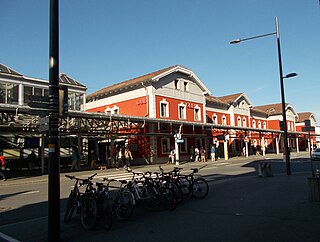
Bludenz railway station serves the city of Bludenz, in the Bludenz district of the Austrian federal state of Vorarlberg. It is owned and operated by the Austrian Federal Railways (ÖBB). Opened in 1872, it forms the junction between the Arlberg railway and the Vorarlberg railway. The station is also a terminus of the Bludenz–Schruns railway (Montafonerbahn).
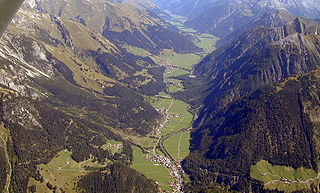
The Lechtal is an alpine valley in Austria, the greater part of which belongs to the state of Tyrol and the smaller part to Vorarlberg. The Lech river flows through the valley.

The Lechquellen Mountains or Lechquellen range is a small mountain group within the Northern Limestone Alps of the Eastern Alps. It lies entirely within the Austrian state of Vorarlberg and includes the upper reaches of the river Lech with its headstreams in a horseshoe shape as well as the Upper Großwalsertal valley.

The Klostertal is an alpine valley in Vorarlberg, in Austria. It branches off at Bludenz and extends about 30 kilometers to the east to the Arlberg and the border with Tyrol. It consists of the three communities of Klösterle am Arlberg, Dalaas and Innerbraz and the three Bludenz towns Bings, Radin and Außerbraz with an area of 193.6 km ² and about 4,700 inhabitants.
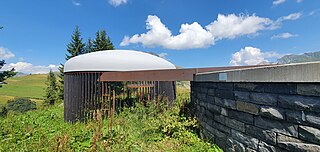
The Skyspace Lech is a walk-in art installation by James Turrell in Tannegg/Oberlech in Vorarlberg (Austria).

The Ski Arlberg ski area is situated in the Arlberg massif in the states of Vorarlberg and Tyrol (Austria).

Stuben am Arlberg is a winter sports resort in the town of Klösterle in the westernmost Austrian province of Vorarlberg. It is located at an altitude of 1,410 meters and had 90 inhabitants.
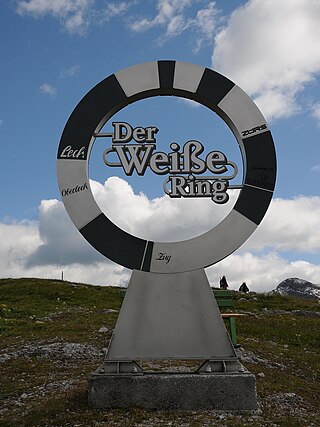
The White Ring is a ski circuit and ski race in the area of Lech am Arlberg, Vorarlberg (Austria). It is located in the Ski Arlberg ski resort. With 22 km, it is the longest ski round trip in the world. It features 5,500 m of altitude difference. The circuit comprises 5 downhill runs, 6 lifts, piste ascents and a cross-country ski run.
The Literaricum Lech is a literary conference in Lech am Arlberg in Vorarlberg (Austria). Its aim is to discuss classic as well as contemporary literature in a way that is accessible, innovative and diverting. It has premiered from 8 to 10 July 2021.

